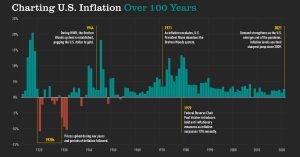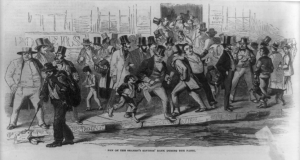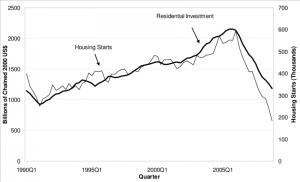Economic Crisis in the history of the US for the last 100 Years

Over the past quarter century, American economists and policymakers have been very active in providing policy advice to other countries about how to avoid and/or manage financial crises. In many cases, the essence of the advice was “you should be more like us.” Suddenly, the United States (US) has been hit by its own financial crisis—one that is extraordinary in both its breadth and severity. While prior financial panics in individual countries or regions have involved output declines of equal or greater magnitude, the global dimensions of the current crisis are unprecedented. The crisis began in the US but has now spread to the rest of the world economy. The transmission channel with Europe has been largely through a linkage of financial markets and institutions on both sides of the Atlantic that shared some of the same flaws and excesses. But for Asia and much of the developing world, the transmission has been largely through an extraordinary collapse of global trade.
This mixed economy did not develop overnight. It has evolved over more than two centuries and has been shaped by American experiences at various times with hardship, war, peace, and prosperity.

The early twentieth century was a time of social and political change in the United States. Public disgust at the corruption and greed of the gilded age encouraged the movement called progressivism. Progressives promoted civic responsibility, worker’s rights, consumer protection, political and tax reform, “trust-busting,” and strong government action to achieve social improvements. The progressive era greatly affected the U.S. economy because of its focus on improving working conditions for average Americans. Successes for the progressives included child labor restrictions, improved working conditions in factories, compensation funds for injured workers, a growth surge in labor unions, federal regulation of food and drug industries, and the formation of the Federal Trade Commission to oversee business practices
20th-Century Recessions
There were 12 recessions in the 20th century. The Great Depression was technically two of the nation’s worst recessions back-to-back.
1907
The “Panic of 1907” lasted from May 1907 to June 1908. It was caused by speculators’ losses that spread to trust companies. These firms acted like banks but had lower reserves. Congress created the Federal Reserve System to prevent future collapses.
1929–38 (The Great Depression)
The biggest economic crisis in U.S. history was two closely related recessions. The first downturn was from August 1929 to March 1933, with a record 12.9% contraction in 1932. The second downturn lasted from May 1937 to June 1938. Unemployment reached 24.9% in 1933 and remained in the double digits until WWII began.
| YEAR | 1930 | 1931 | 1932 | 1933 | 1934 | 1935 | 1936 | 1937 | 1938 | 1939 |
|---|---|---|---|---|---|---|---|---|---|---|
| GROWTH RATE | -8.5% | -6.4% | -12.9% | -1.2% | 10.8% | 8.9% | 12.9% | 5.1% | -3.3% | 8.0% |
| UNEMPLOYMENT | 8.7% | 15.9% | 23.6% | 24.9% | 21.7% | 20.1% | 16.9% | 14.3% | 19.0% | 17.2% |
Several factors combined to create the Great Depression. The Fed raised interest rates in the spring of 1928 and continued despite the recession. The 1929 stock market crash destroyed businesses and life savings. A 10-year drought in the Midwest created the Dust Bowl that devastated farmers.
The New Deal ended the first recession, boosting growth by 10.8%. The second recession ended when the drought did, and the government increased spending for World War II.
1945
This recession lasted eight months, from February to October. It was a natural result of the demobilization of World War II.
1949
This 11-month recession began in November 1948 and lasted until October 1949, when unemployment peaked at 7.9%. It was caused by the Fed raising interest rates too quickly.
| GDP GROWTH | Q1 | Q2 | Q3 | Q4 |
|---|---|---|---|---|
| 1949 | -5.4% | -1.4% | 4.2% | -3.3% |
1953
This recession lasted 10 months, from July 1953 to May 1954. It resulted from tightened monetary policy following the Korean War. Unemployment didn’t reach its peak of 6.1% until September 1954, four months after the recession ended. In 1953, GDP contracted by 2.2% in the third quarter and by 5.9% in Q4. In 1954, it contracted by 1.9% in the first quarter.
1957
In this recession, which took place from August 1957 to April 1958, GDP fell 4.1% in Q4 1957, then contracted to a low of 10.0% in Q1 1958. Unemployment didn’t reach its peak of 7.5% until July 1958. The Fed’s contractionary monetary policy caused this economic slowdown.
1960
Starting in April 1960, this recession lasted 10 months until February 1961. GDP was -2.1% in Q2 1960, rose by 2.0% in Q3, but was down by 5.0% in Q4. Unemployment reached a peak of 7.1% in May 1961.
NOTE :
President John F. Kennedy ended the 1960 recession with stimulus spending. His opponent, Richard Nixon, blamed the recession for costing him the election.
1973-75
This recession lasted 16 months, from November 1973 to March 1975. The OPEC oil embargo is blamed for quadrupling oil prices, but actions taken by President Richard Nixon also contributed to the recession.
First, Nixon instituted wage-price controls. They kept prices too high, reducing demand. Wage controls made salaries too high and forced businesses to lay off workers. Second, Nixon took the United States off the gold standard in response to a run on the gold held at Fort Knox, which led to inflation. The price of gold skyrocketed while the dollar’s value plummeted.
The result was stagflation and five quarters of negative GDP growth: 1973 Q3, -2.1%; 1974 Q1, -3.4%; Q3, -3.7%; Q4, -1.5%; and 1975 Q1, -4.8%. Unemployment reached a peak of 9.0% in May 1975, two months after the recession ended.
1980-82
The economy suffered a double whammy of two recessions in this period. There was one during the first six months of 1980. The second lasted 16 months, from July 1981 to November 1982. The Fed caused this recession by raising interest rates to combat inflation. That reduced business spending. The Iranian oil embargo aggravated economic conditions by reducing U.S. oil supplies, which drove prices up.
GDP was negative for six of the 12 quarters. The worst was Q2 1980 at -8.0%. Unemployment rose to 10.8% in November and December 1982. It was above 10% for 10 months.
| GDP GROWTH | Q1 | Q2 | Q3 | Q4 |
|---|---|---|---|---|
| 1980 | 1.3% | -8.0% | -0.5% | 7.7% |
| 1981 | 8.1% | -2.9% | 4.9% | -4.3% |
| 1982 | -6.1% | 1.8% | -1.5% | 0.2% |
1990-91
This recession ran for nine months, from July 1990 to March 1991. It was caused by the 1989 savings and loan crisis, higher interest rates, and Iraq’s invasion of Kuwait. GDP was -3.6% in Q4 1990 and -1.9% in Q1 1991. Unemployment peaked at 7.8% in June 1992.
Note:
Recessions are easier tracked in hindsight. The Bureau of Economic Analysis (BEA) makes initial projections about Gross Domestic Product (GDP) early each quarter and then revises its GDP estimates as it receives new data, a process that usually takes place in July. It can be difficult to correct a recession once it’s already started.
21st-Century Recessions
In its first decade, the 21st century experienced three recessions. Each was worse than the one before it, but for different reasons.
2001
The 2001 recession lasted eight months, from March to November. It was caused by a boom and subsequent bust in dot-com businesses. The Y2K scare partially created the boom in 2000. Companies bought billions of dollars worth of new software because they were afraid the old systems weren’t designed to transition from the 1900s to the 2000s. Many dot-com businesses were significantly overvalued and failed.
The 9/11 attack worsened the recession. The economy contracted in two quarters: Q1 by -1.3% and Q3 by -1.6%. Unemployment continued rising until it peaked at 6.3% in June 2003.
2008–09 (The Financial Panic)
The housing price bubble burst in mid-2006 and both housing prices and housing starts began a long period of contraction. With declining home prices, borrowers were unable to refinance their loans, and default rates soared. Against this backdrop, problems in the markets for mortgages and mortgage-backed securities festered for over two years. The situation exploded into a full-blown financial panic only in September of 2008 with three major events: the government takeover of Fannie Mae and Freddie Mac on 8 September, the Lehman bankruptcy on 15 September, and the Federal Reserve’s bailout of AIG on 16 September. In all three cases, the firms were unable to refinance their debt because of increasing investor/partner uncertainty.

The Great Depression lasted from December 2007 to June 2009, the longest contraction since the Great Depression. The subprime mortgage crisis triggered a global bank credit crisis in 2007. By 2008, the damage had spread to the general economy through the widespread use of derivatives.
GDP in 2008 shrank in three quarters, including an 8.5% drop in Q4. The unemployment rate rose to 10% in October 2009, lagging behind the recession that caused it.
| YEAR | Q1 | Q2 | Q3 | Q4 |
|---|---|---|---|---|
| 2008 | -1.6 | 2.3 | -2.1 | -8.5 |
| 2009 | -4.6 | -0.7 | 1.5 | 4.3 |
The recession ended in Q3 2009, when GDP turned positive, thanks to the American Recovery and Reinvestment Act
2020 COVID-19 Impact on US Economy
The 2020 COVID-19 Impact on US Economy was the worst since the Great Depression. The U.S. economy contracted a record 31.2% in the second quarter after falling 5.1% in the previous quarter.
In April 2020, the U.S. economy lost an astonishing 20.5 million jobs, sending the unemployment rate skyrocketing to 14.7%. It remained in the double digits until August. Uncertainty over the pandemic’s impact also caused the 2020 stock market crash.
The Federal Reserve lowered the fed funds rate to 0%, promising to keep it there until 2023. Congress issued billions of dollars in aid. Although the economy grew 33.8% in the third quarter, it was not enough to make up for earlier losses.
